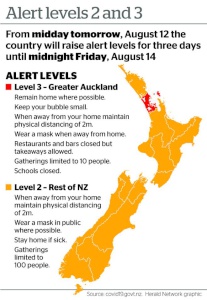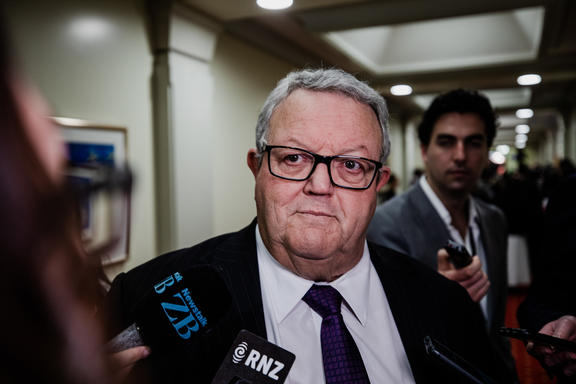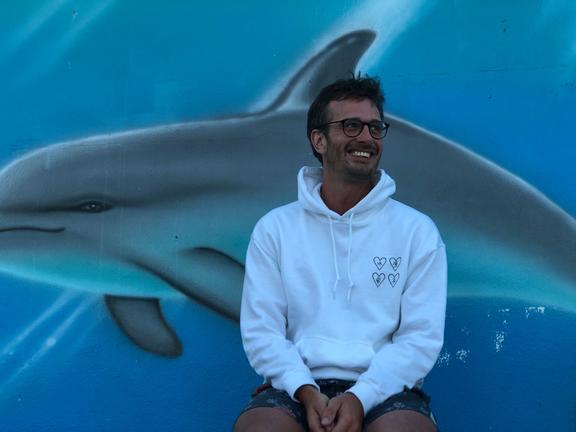The announcement that Auckland was going into lockdown for a second time was met with a deluge of conspiracy theories and misinformation, including from several prominent political figures. That "infodemic" is forcing journalists to confront the question of how they should report on the rapid rise of social media-fueled conspiracy movements.
In the hours after Prime Minister Jacinda Ardern announced Auckland would be moving back into lockdown, Billy Te Kahika Jr did something he'd done many times before, and switched on Facebook Live.
The New Zealand Public Party leader launched into a familiar refrain.
“We have been saying for over a month now this lockdown was coming. We did say it would be the second week of August,” he said.
Te Kahika’s insinuation that this week’s lockdown was planned in advance was false.
Ardern and director general of health Ashley Bloomfield have both said they found out about the new Covid-19 outbreak roughly five hours before the lockdown announcement.
There's no evidence they're lying, and plenty they're telling the truth.
In the past, theories like Te Kahika's might have been more easily sidelined. But the blues musician from Whāngarei has built up a substantial following on social media since he started posting screeds of misinformation and conspiracy theories during the last lockdown in March.
- How to deal with whānau caught up in conspiracies
- Kiwis outside of Auckland mocked, laughed at for wearing face masks
- Kiwis react with anger at revelations of lack of testing at border
- Where did the Covid-19 outbreak come from?
Thanks to what he calls his research, his Facebook audience has grown from a few hundred to more than 20,000. His New Zealand Public Party meetings have been met with packed halls.
On Tuesday, Te Kahika's theory spread rapidly online.
It was echoed by celebrities, including the Australian chef Pete Evans, who said the lockdown was a "scam", in a post that linked back to the New Zealand Public Party.

Popular Instagram influencer Zoe Fuimaono, who goes by the handle @blessedindoubles, implied the new health measures were helping usher in military rule.
Even National Party deputy leader Gerry Brownlee was accused of engaging in conspiratorial thinking, after hinting that the government had known more about the resurgence of Covid-19 than it was letting on in a press conference on Wednesday.
These sorts of ideas became so prevalent that Ardern had to address them multiple times at press conferences on Wednesday.
“I’ve heard suggestion that we may have had this information earlier than we had said. There is no reason why we would ever do that,” she said on Wednesday morning. “I do worry that those kinds of theories do nothing to support what needs to be collective action from all of us.”
That afternoon, Ardern characterised Brownlee's implied allegations as “nonsense”.
The media was also quick to cast a skeptical eye over the outbreak of conspiratorial thinking, with RNZ’s Kim Hill repeatedly bringing up Brownlee’s claims during a withering interview with National Party leader Judith Collins on Thursday’s Morning Report.
A group of 50 health experts signed an open letter urging politicians to stop undermining public health messages on Covid-19.
But even if it was strongly condemned by the government, medical professionals and the media, the boil-up of misinformation highlights a problem facing authorities as they try to stamp out Covid-19 for a second time.
They’re now essentially dealing with two parallel crises: the virus and the maelstrom of misinformation surrounding it, which the WHO has termed an “infodemic”.
 Recent news reports have hinted at the sheer scale of ill-informed, and often conspiratorial belief driving that infodemic.
Recent news reports have hinted at the sheer scale of ill-informed, and often conspiratorial belief driving that infodemic.
An internal Facebook report leaked to NBC showed the social media platform hosts thousands of pages linked to the conspiracy theory QAnon, with millions of followers between them.
Even a recently-elected Republican member of the US House of Representatives is associated with QAnon.
Widespread conspiratorial thinking has fed into that country’s disastrous Covid response, helping to undermine public health messages.
In an article on Thursday, Newsroom’s Sam Sachdeva argued comments like Brownlee’s risk moving New Zealand in the same direction.
“Making ominous references to ‘interesting facts’... runs the risk of undermining public buy-in for a longer lockdown, should one be required,” he wrote.
“As the US has torn itself apart over a politicised Covid response as deaths shoot upwards, we have patted ourselves on the back.
“Such complacency on the health front has proved to be a mirage - we can only hope the quality of our political discourse does not similarly evaporate.”
Brownlee has since backtracked on his comments, saying it wasn't his intention to play into the hands of conspiracy theorists.
Even if Brownlee didn't mean to aid those groups, modelling from Te Pūnaha Matatini shows the latest lockdown has been met with a spike in online disinformation.
The question of how to cover conspiracies
Despite the increasing real-world harm caused by conspiracy theories, many media outlets devote few resources to covering online misinformation, and those that do are often guilty of delivering uncritical coverage.
Nelson's Mainland TV has been criticised for airing the discredited documentary Plandemic in full, despite it containing an abundance of falsehoods and misinformation about Covid-19.
A Gisborne Herald report on one of Te Kahika’s meetings from July 8 was simply headlined ‘Global plandemic’. It lead with the startling header:
“Labour "communists" Jacinda Ardern and Ashley Bloomfield are complicit in a global agenda of state control that involves construction of the coronavirus “plandemic”.
"New Zealand Public Party founder and lay minister Billy Te Kahika made that claim to a packed room at Waikanae Surf Life Saving Club on Saturday night.”
The Raglan Chronicle struck a similar tone in its coverage of one of those meetings, spelling out many of his more outlandish beliefs without surrounding context, under the headline ‘Post-lockdown Billy Te Kahika event attracts many’.
Stuff’s Charlie Mitchell, who recently wrote a lengthy feature on Te Kahika’s rise, said he had to wrestle with some ethical questions before embarking on the story.
He had to weigh two competing ideals: his desire to not give a platform to information that’s false or misleading, and his imperative to cover matters of public interest in a way that’s fair, and gives people a right of reply.
“In this case those two ideas are in conflict with each other. You can’t really have both. To accurately characterise what Billy Te Kahika believes, you have to by definition have to repeat information that is false or at best unsubstantiated.”
Mitchell decided not to take an adversarial approach with his feature, opting instead to put Te Kahika’s beliefs in proper context.
“We didn’t go in all guns blazing, prosecuting a case against conspiracy theories or Te Kahika specifically. We just wanted to recognise that these conspiracy theories exist and if you want to understand why you have to listen to these people and talk to them in a way that isn’t judgemental, which is a very fine line to walk.”

Documentary maker and journalist David Farrier advocates a similar approach to dealing with conspiracy theorists.
“I think being kind and open to these people is important and also just showing there are shades of grey. You can talk to your friend that’s into that stuff say ‘yeah I don’t always trust institutions and the government either, I don’t always think they have my best interests at heart, but where I start to become a bit skeptical is that I’m pretty confident that 5G towers aren’t being installed to spread Covid-19’,” he said. “Chip away, slowly.”
Farrier keeps tabs on the rise of movements like QAnon in New Zealand through his blog Webworm. He regularly features interviews with conspiracy theory experts on how to debunk misinformation, and deter people from falling into online rabbit holes in the first place.
But that’s not enough, he said. He wanted more media attention to be devoted to conspiracy movements, as they make a social media-enabled move from the fringes into the mainstream.
“I would love to see this stuff we’re talking about going out to a much wider audience,” he said. “I think we need to be talking about this stuff on a much grander scale, and contextualising it, because you can’t just report that ‘hey a bunch of people out there believe that 5G is giving us cancer or it’s actually going to give us Covid-19’. We have to explain why this stuff’s happening, why we’re hearing all this dialogue. We have to critically pull it apart so hopefully we can stop it from spreading further.”





